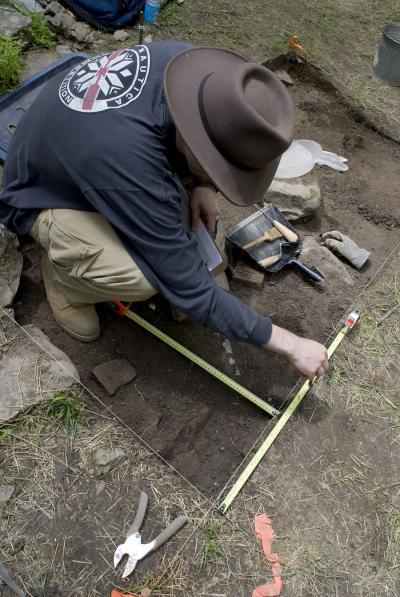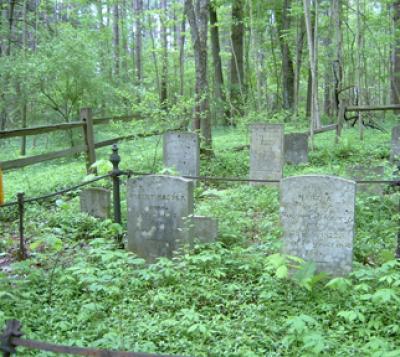About 250 years before Daniel Massey built his farm house in Huntingdon County, Pennsylvania, his great-grandfather came to the New World as an indentured servant. 150 years later, Penn State's Archaeological Field School is excavating Daniel's house to see how far he came from those humble beginnings.
"I think historic archaeology can engage a little more directly than the prehistoric archaeology we sometimes do," says Dr. Claire Milner, director of the field school and director of exhibits and curator of Penn State's Matson Museum of anthropology. "It is more obvious and immediate who the people were and what the artifacts are." Student measures artifact location for mapping. Credit: Greg Grieco, Penn State
Student measures artifact location for mapping. Credit: Greg Grieco, Penn State
The cemetery on the hill, which contains Masseys and a few other individuals, is an indication that the Massey presence in the area was substantial. However, without the aid of Joe Harding, Penn State director of forest land, the Massey home and its history may have remained hidden in the woods.
Harding, during a survey to establish a 50-year forest management plan for the university's 8860 acres of forest land, located more than 40 archaeological sites in the Stone Valley forest. The University manages the forests through tree harvesting, sales, tree planting, fencing out deer and as a venue for research, teaching and demonstration. Harding contacted Milner, planting the seeds of the field school.
"I love it," says Bianco. "It is a lot more interesting than expected. We are finding glass and nails. I can really get into it and with the documents it becomes clear that real people lived here." Micah Stroud, a Penn State senior and an intern, pursued an independent study last year working on the nails collected at the site. He investigated what they were made of, how they were made and what happens to them when they, and the house, fall down. View of the Massey cemetery associated with Daniel Massey's home. Credit: Claire Milner, Penn State
View of the Massey cemetery associated with Daniel Massey's home. Credit: Claire Milner, Penn State
"A nail is just one piece of the puzzle," says Stroud. "With nails we can place the dates of the house occupation between 1840 and 1870."
This year's students are excavating what is left of the walls of the house and a basement area. Besides nails, glass, window glass and pottery, they find lantern parts and various household goods. Included in their discoveries is a buried oval, blue and white, speckled, roasting pan, similar or identical to one found on store shelves today.
It probably dates to an occupation in the 1930s, but while Milner knows that the site was occupied then, she does not know who lived there.
While the students have learned much, there are still many unexplained questions, especially about the architecture at the site. Historians and records seem to indicate that the house was stone, but there are some bricks showing up in the rubble. More confusing is that there appear to be at least two and perhaps more building episodes.
"One wall cuts off a part of a room that was built before it," says Milner. "We do not yet know why this part of the house was rebuilt."
As the excavation continues this year, Milner and the students hope to understand better the layers at the house and the surrounding area. While Milner does not think that next year’s field school will operate in the same location, she does hope that she can do some shovel testing to identify outbuildings and outdoor areas. There is also what is probably a springhouse up the hill that remains untouched.
Source: Penn State